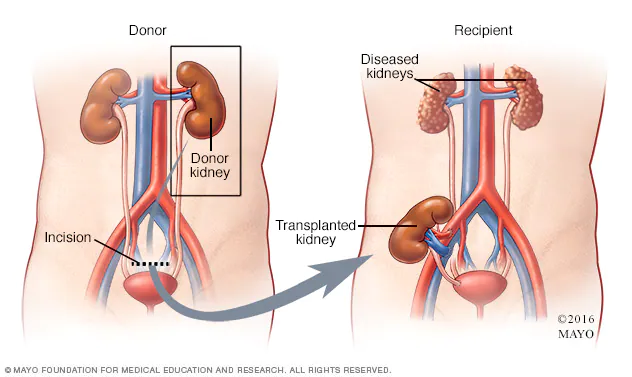Laparoscopic Nephrectomy
This information is designed to help you, your family and friends prepare for your surgery. It will also help you plan how to take care of yourself in the weeks following discharge from hospital.
A laparoscopic nephrectomy is an operation to remove one of the two kidneys that sit at the back of the abdominal cavity. The kidneys make urine by filtering waste products and excess fluid from the blood. Urine drains from the kidneys, through the ureters into the bladder where it is stored until the person is ready to go to the toilet. A laparoscopic nephrectomy involves removing an entire kidney through keyhole incisions in the flank, the side of the body between the ribs and the hip.
A nephrectomy is usually done for one of two reasons, either for cancer of the kidney or because of a non- functioning kidney.
- In the case of kidney cancer a radical laparoscopic nephrectomy is done. This is done in an attempt to rid the body of cancer by removing the entire kidney and adrenal gland, with its surrounding fat and attached vessels. In more advanced cases it may be done to stop continued bleeding from the effected kidney.
- For non-functioning kidneys, which are either caused by large stones, a lack of blood supply or abnormal kidney structure, a simple laparoscopic nephrectomy is done. This is where only the kidney itself is taken and the adrenal gland and other structures are left behind. A simple nephrectomy is usually done to avoid recurrent infection and pain and the possibility of severe illness because of infection.

Treatment
A laparoscopic nephrectomy removes the kidney by using laparoscopic equipment. Long thin instruments are passed through up to five small incisions made in the flank, each about 1cm in length. The abdomen is first filled with carbon dioxide, which separates the tissues to allow for vision during the surgery. A camera is then passed, giving the urologist a detailed picture inside the abdomen. The other incisions are used to pass cutting and suturing instruments so the blood supply to the kidney can be isolated and tied off and the kidney removed either with or without its surrounding structures. A wound drain is then inserted to drain any wound ooze. This is usually stitched in place and stays in for 1 – 2 days.
When the operation is finished, the carbon dioxide air is removed from the abdomen and the cuts are stitched closed with dissolving stitches. The areas are then covered with small plasters. A catheter (drainage tube which drains urine from the bladder) is also inserted to monitor the urine output from the remaining kidney. The catheter usually stays in for 1 – 2 days, or until you are up and about. Laparoscopic Nephrectomy takes approximately 2 – 4 hours to perform and involves a hospital stay of around 1 – 2 nights
What Are The Risks Involved With a Nephrectomy
With all surgery, there is a risk of infection and blood loss. The kidneys have a large blood supply and there is always some bleeding involved with surgery. Antibiotics are often given during the operation to prevent infection. In a small number of cases, a blood transfusion may be needed to compensate for blood loss during surgery. If you do need a blood transfusion and you want to refuse one, it is vital that you tell your surgeon and nurse prior to your operation. It is possible to donate some of your own blood prior to surgery. If you would like to do this please discuss it with your surgeon. In any laparoscopic surgery, there is also the risk that the surgeon may need to proceed to open surgery, requiring a single, larger incision in the flank. This happens rarely and can be due to equipment failure, excessive bleeding or other difficulties encountered during the surgery.
Your Consent
We need your permission for your operation to go ahead. Before you sign the consent form it is important that you understand the risks and effects of the operation and anaesthetic. Your doctor and the nurse will discuss this with you, should you have any questions, your nurse or doctor would be happy to answer these.
If you would like your kidney returned to you for personal reasons, please discuss this with your family and inform your nurse and surgeon before your operation.

